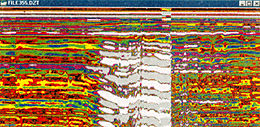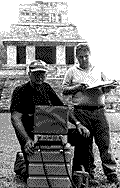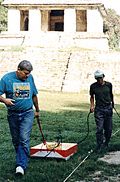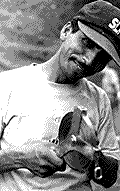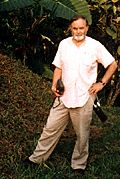|
Survey lines were located at one meter intervals across the Stephens Plaza of the Cross Group. Detailed traverses were made within and around the Temple of the Cross building, along the west slope, and on the south side of the substructure. In addition, exploratory survey lines were conducted where feasible on Temple XX.
The sophisticated GPR technology points out anomalies in the composition of the soil and rocks below the surface that may indicate there is a change, such as a void or concentration of stones that is different from the surrounding areas. This provides a tool that can be of great benefit in locating areas for investigation where there are no surface indications.
The geophysical report of the GPR indicated seven or eight anomalies that could be investigated at a number of locations in Stephens Plaza, as well as in three distinct locations on the Temple of the Cross: at the first landing, the SW corner of the TC platform, and the west side of the platform of the temple.
Analysis of this new data (Hanna et al, Estudio Geofisico en la Zona Arqueologica de Palenque, Chiapas, Mexico ) noted that the deeper signals in these regions clearly indicate the presence of voids and localized objects--possibly stone remnants or artifacts. The anomalous region of the Temple of the Cross mostly contains hyperbolic echoes, possibly associated with sonte remnants or artifacts, and some honeycombing, possibly associated with voids.
The geophysical survey done in 1996, along with calibrations of the results from archaeological excavations, help confirmed this new approach in archaeological research. It may help with the design of future archaeological projects in the Maya region.
Without excavations, the inferences about remotely sensed objects and voids will remain only conjectural.
Only when a subset of reflected targets is excavated will a definate correlation of signal-to-archaeological features by possible (Hanna et al, op cit ).
This work was financed by the GeoOntological Development Society. The National Geographic Society provided the equipment and a member of their technical staff for the GPR investigation. The survey was performed by Claude 'Pete' Petrone, Dr. William Hanna, and Roger Helmandollar (NGS), with Carlos Alcudid Garcia and Julian Antonio de la Cruz of Palenque.
| 